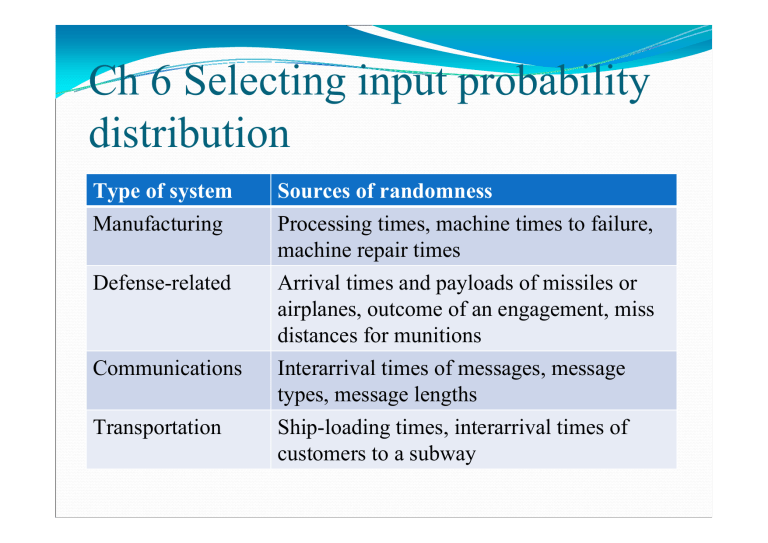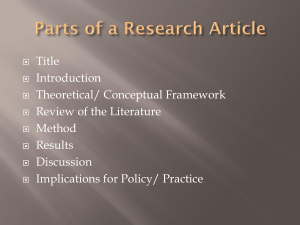
Ch 6 Selecting input probability distribution Type of system Manufacturing Defense-related Sources of randomness Processing times, machine times to failure, machine repair times Arrival times and payloads of missiles or airplanes, outcome of an engagement, miss distances for munitions Communications Interarrival times of messages, message types, message lengths Transportation Ship-loading times, interarrival times of customers to a subway y A single-server queueing system has exponential interarrival times with a mean of 1 minute. Suppose that 200 service times are available from the system, but their underlying probability distribution is unknown. Service-time distribution Average delay in queue Average number in queue Proportion of delays ≧20 Exponential 6.71 6.78 0.064 Gamma 4.54 4.6 0.019 Weibull 4.36 4.41 0.013 Logormal 7.19 7.3 0.078 Normal 6.04 6.13 0.045 Specify a distribution y Approach 1: the data values themselves are used directly in the simulation y Approach 2: the data values themselves are used an empirical distribution function y Approach 3: standard techniques of statistical inference are used to “fit” a theoretical distribution form to the data and to perform hypothesis tests to determine the goodness of fit y Drawback of approach 1 y The simulation can only reproduce what has happened historically y There is seldom enough data to make all the desired simulation runs y Approach 2 avoids these shortcomings (for continuous data) y If a theoretical distribution can be found that fits the observed data reasonably well, then this will generally be preferable to using an empirical distribution for the following reasons: y An empirical distribution function may have certain “irregularities,” particularly if only a small number of data values are available y If empirical distributions are used in the usual way, it is not possible to generate values outside the range of the observed data in the simulation y There may be a compelling physical reason in some situations for using a certain theoretical distribution form as a model for a particular input random variable. y A theoretical distribution is a compact way of representing a set of data values. y A theoretical distribution is easier to change. 6.2 Useful probability distribution y The purpose is to discuss a variety of distribution that have been found to be useful in simulation modeling and to provide a unified listing of relevant properties of these distributions. y Continuous distribution (CD) y Discrete distribution (DD) 6.2.1 Parameterization of CD y Three types of parameters y Location parameter γ specifies an abscissa (x axis) location point of a distribution’s range of values. (usually γ is the midpoint or lower endpoint of the distribution’s range) y Y=X+ γ y Scale parameter β determines the scale (or unit) of measurement of the values in the range of the distribution. y Y= β X y Shape parameter α determines, distinct from location and scale, the basic form or shape of a distribution within the general family of distributions of interest. 6.2.2 Continuous distribution y Uniform y Exponential y Gamma y Weibull y Normal y Longormal y Beta y Pearson type V, VI y Log-logistic y Johnson SB , SU y Triangular Discrete distribution y y y y y y Bernoulli Discrete uniform Binomial Geometric Negative binormal Poisson 6.3 Techniques for assessing sample independence


